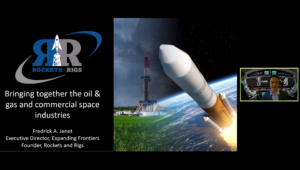Cross-industry initiative seeks to bring aerospace technologies to the rig site
By Jay Stracke, Editorial Coordinator
In many ways, a drilling rig is comparable to the International Space Station. They’re both remote installations with a complicated infrastructure, and both face a multitude of harsh and unpredictable environmental conditions. The Rockets & Rigs initiative, established in 2017, was borne out of a recognition of these similarities and the potential value in furthering exchanges of technology and expertise, according to project founder Fredrick Jenet. In a presentation at the virtually held 2020 IADC Advanced Rig Technology Conference on 2 September, Dr Jenet discussed the initiative’s ongoing efforts to foster collaboration between the oil and gas community and the space exploration industry.

The space industry, like oil and gas, has seen rapid changes in recent years as humans seek to build out its world into outer space. “What was once exclusively the domain of governments is now being handed over into private industry and commercial operations,” Dr Jenet noted.
Amid this transition, public and private organizations began looking more closely at how to build a sustainable space economy. It led to the recognition that the oil and gas industry would be an appropriate partner in this journey, not only because of its engineering expertise but also because of its “unique skill of being able to do practical innovation,” Dr Jenet said. “You innovate, but you innovate with value in mind.”
Vice versa, the Rockets and Rigs initiative also wanted to look at existing NASA technologies to determine how they could be useful for the oil and gas industry. To survey these potential technologies, the initiative hosted two “hackathons” in 2018 and 2019, bringing together technology experts from both industries. The first hackathon canvassed a large number of technologies and ultimately identified 13 that could be useful for the oil and gas industry. During the second event, experts took a deeper dive into those 13 technologies and developed value propositions, as well as roadmaps to commercialization. Oil and gas representation at this second event included operators like ExxonMobil and Chevron, as well as oilfield service and equipment manufacturing companies like Baker Hughes and National Oilwell Varco.
Out of the initial 13 technologies, nine were found to have the most potential, and four of those have since seen additional development: a non-invasive chemical sensor, a water treatment technology, a lightweight battery and a robotic pipe inspection system. In fact, a new startup company was recently launched around the chemical sensor technology. Permittivity, the first Rockets & Rigs company, aims to leverage this NASA technology to solve problems with fluid container and transportation solutions.
A second startup company is also in the works, Dr Jenet said. Pura Technologies will be based on NASA’s water pre-treatment technology and work to develop water recycling solutions for the oilfield.
While the initiative’s activities so far have focused on bringing aerospace technologies into oil and gas, Dr Jenet said he also hopes to identify technologies from the shelves of oil and gas companies, such as sensors for harsh environments, that could be transferred to the space industry. “That’s definitely the next phase of the Rockets & Rigs development,” he said.
Individuals or companies interested in participating in Rockets & Rigs can contact Dr Jenet here.




